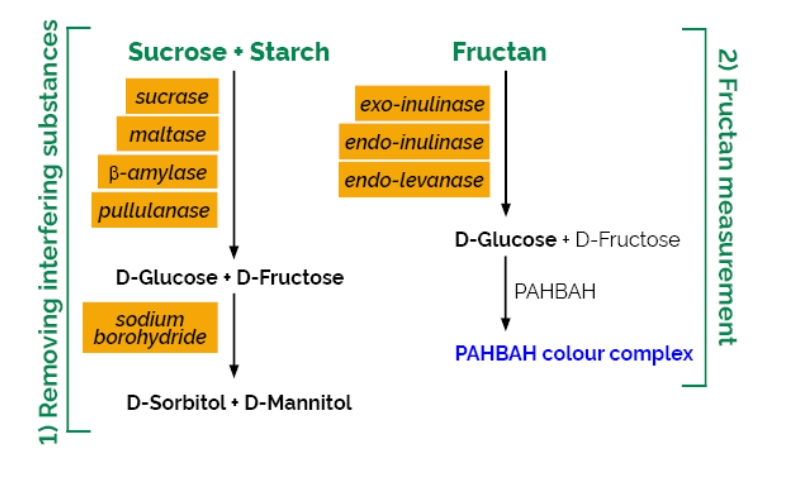- 背景資料
果糖的聚合物(Fructan)被定義為含有一個或多個fructosyl- fructose linkage,並以此鍵結為主體之物質,根據聚合物的大小和具體特徵(specifically characterised)可區分為低聚物(oligomer)和聚合物(polymer)。果糖的聚合物(Fructan)根據分子結構和分子量的不同,可分成三種:
1️⃣菊糖(inulin)類型:主要以β(2→1)糖苷鍵鍵結
2️⃣果聚糖(levan)類型:主要以β(2→6)糖苷鍵鍵結
3️⃣禾本科(graminan-type)(支鏈)類型:同時具有大量的β(2→1)和β(2→6)糖苷鍵鍵結
商業上果聚糖(levan)的量產,以細菌生產為主,利用蔗糖為碳原藉由細菌的分解酵素(levansucrase)產生果聚糖。果聚糖具有低熱量、低黏度和高水溶性的特性,在食品工業上可當作乳化劑、成型劑、穩定劑、增稠劑及風味攜帶劑等。此外,根據相關的動物研究數據顯示,果聚糖具有抗腫瘤的能力、降低血液中膽固醇的濃度,作為益生素(元)(Prebiotics)...等保健功效。 - A. Fructan Extraction
Samples containing 0-10% (w/w) fructan
Accurately weigh approx. 400 mg of the sample into a dry pyrex screw cap culture tube (25 x 150 mm) and add 25 mL of distilled water. Loosely cap the tube. Place the tube into a boiling water bath and heat for a total of 10 min. After 5 min, tighten the tube cap and vigorously mix the contents by inversion and shaking the tube. Return the tube to the boiling water bath. After a further 5 min, remove the tube from the boiling water bath and again mix the contents by inversion and shaking.
Samples containing 10-40% (w/w) fructan
Accurately weigh approx. 100 mg of the sample into a dry pyrex screw cap culture tube (25 x 150 mm) and add 25 mL of distilled water. Loosely cap the tube. Place the tube into a boiling water bath and heat for a total of 10 min. After 5 min, tighten the tube cap and vigorously mix the contents by inversion and shaking. Return the tube to the boiling water bath. After a further 5 min, remove the tube from the boiling water bath and again mix the contents by inversion and shaking. In each case, allow the tube contents to cool to room temperature and then transfer ~ 2.0 mL into 2.0 mL microfuge tubes and centrifuge at 13,000 rpm for 5 min.
NOTE: For samples containing 40-100% (w/w) fructan, add 1 mL of centrifuged extract to 2 mL of water and proceed with the assay.
- B. Removal of Sucrose, Starch and Reducing Sugars:
1. Accurately dispense a 0.2 mL aliquot of the solution to be analysed (containing approx. 0.1-1.0 mg/mL of fructan) into the bottom of a glass test tube (16 x 100 mm).
2. Add 0.2 mL of diluted Sucrase/Amylase solution (Enzyme Solution A) and incubate the tube at 30°C for 30 min.
NOTE: If samples contain very high levels of sucrose and maltodextrins (e.g. baby milk formulations), increase this incubation time to 60 min to ensure complete hydrolysis of these oligosaccharides.
3. Add 0.2 mL of Reagent 3 (alkaline borohydride solution) to the tube, stir vigorously and cover the tubes with Parafilm®. Incubate the tubes at 40°C for 30 min to effect complete reduction of reducing-sugars to sugar alcohols.
4. Add 0.5 mL of Reagent 4 (200 mM acetic acid) to the tube with vigorous stirring on a vortex mixer. A vigorous effervescence should be observed (this treatment removes excess borohydride and adjusts the pH to approx. 4.5). This is termed Solution S.
- C. Hydrolysis and Measurement of Fructan:
1. Accurately and carefully transfer 0.2 mL aliquots of Solution S into the bottom of 3 glass test-tubes (16 x 100 mm).
2. Add 0.1 mL of fructanase solution (Enzyme Solution B) to 2 of these tubes (samples) and 0.1 mL Buffer 2 (100 mM sodium acetate) to the third (sample blank).
3. Incubate the tubes at 40°C for 30 min to effect complete hydrolysis of fructan to Dfructose and D-glucose. Seal the tubes with Parafilm® during incubation.
4. Add 5.0 mL of PAHBAH Working Reagent to all tubes [samples, sample blanks, the Dfructose standard (see Controls and Precautions 2.b), reagent blank (Controls and Precautions 2.a) and the extract of the inulin/cellulose control and/or the levan/ cellulose control] and incubate in a boiling water bath for exactly 6 min.
5. Remove the tubes from the boiling water bath and immediately place them in cold water (18-20°C) for approx. 5 min.
6. Measure the absorbance of all solutions at 410 nm against the reagent blank. Measure the absorbance values as soon as possible after cooling the tubes. The PAHBAH colour complex fades with time.
商品特色
商品規格
- 商品規格(100個檢測反應)
Bottle 1:
Sucrase plus β-amylase, pullulanase and maltase as a freeze- dried powder.
Store below -10°C. See individual label for expiry date.
Bottle 2: (x2)
Fructanase. Recombinant exo- and endo-inulinases and recombinant endo-levanase as a freeze-dried powder.
Store below -10°C. See individual label for expiry date.
Bottle 3:
Inulin Control Flour. Inulin freeze-dried in the presence of α-cellulose.
Store at room temperature. See individual label for expiry date.
Bottle 4:
Levan Control Flour. Timothy grass levan freeze-dried in the presence of αcellulose.
Store at room temperature. See individual label for expiry date.
Bottle 5:
Sucrose Control Flour. Sucrose freeze-dried in the presence of α-cellulose.
Store at room temperature. See individual label for expiry date.
Bottle 6:
D-Fructose Standard Solution (1.5 mg/mL) in 0.2% (w/v) benzoic acid.
Store at room temperature. See individual label for expiry date.
- PREPARATION OF ENZYMES
1. Dissolve the contents of bottle 1 (Sucrase and β-amylase etc) in 22 mL of Buffer 1 [sodium maleate (100 mM, pH 6.5 plus Bovine serum albumin (0.5 mg/mL)] (Enzyme Solution A). Divide into aliquots of appropriate volume and store in polypropylene tubes. Stable for ≤ 2 years below -10°C.
2. Dissolve the content of one of bottle 2 (Fructanase) in 11 mL of Buffer 2 [sodium acetate (100 mM, pH 4.5]. This is Enzyme Solution B. Divide into aliquots of appropriate volume and store in polypropylene tubes. Stable for 4 months below -10°C. Do not dissolve the remaining bottle 2 (Fructanase) until it is required.
NOTE: The volume required to re-suspend bottle 2 (Fructanase) differs from that stated in the AOAC methods (999.03, 2016.14, 2018.07) but the concentration of the resulting Enzyme solution B remains the same. Therefore it can be used as normal in the remaining steps of these methods.
Use the contents of bottles 3, 4, 5 and 6 as supplied.
Stable for > 5 years at room temperature.



